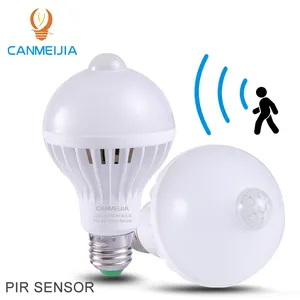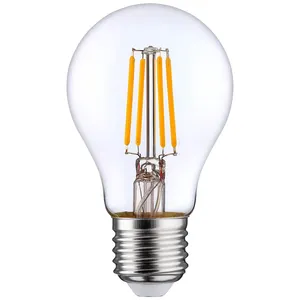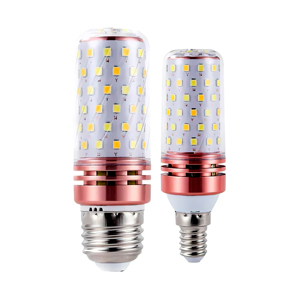(168913 products available)











































































































































































































































LED bulbs are light sources that have become widely used because they are more energy efficient and have a longer lifespan than traditional incandescent light bulbs. But LED bulbs come in many different types and styles, depending on their shape and function.
Below are the different kinds of LED light bulbs;
Standard LED bulbs:
These are the most common types of LED light bulbs. They are used for general lighting in homes and offices. Standard LED bulbs are available in different sizes and shapes, such as A19 and A60. They use less energy than incandescent bulbs and have a longer lifespan.
CFL LED bulbs:
CFL LED bulbs combine fluorescent and LED technologies. They are designed to be more energy efficient than both standard incandescent and CFL bulbs. These bulbs are commonly used in applications where longer life and energy efficiency are more important than brightness.
Smart LED light bulbs:
These LED light bulbs are designed for modern, high-tech homes. They can be controlled remotely by smartphone applications or by voice commands. Voice assistant devices like Amazon Alexa and Google Assistant can be used to control them. Smart LED bulbs come in different colors and brightnesses, and they use very little energy.
Decorative LED bulbs:
These LED light bulbs are made for decorative purposes. They have different shapes and sizes that produce various colors of lights. They include globe LED bulbs, filament LED bulbs and Edison-style LED bulbs.
Specialized LED bulbs:
Specialized LED light bulbs are made for particular uses. For example, they can be used for recessed lighting, track lighting or landscape lighting.
Halogen LED bulbs:
These light bulbs use halogen gas to produce light. They are more energy efficient than incandescent bulbs, and they have a longer lifespan. Halogen LED bulbs are commonly used in automotive lighting and in homes.
Incandescent LED bulbs:
These bulbs produce light using a wire that is heated to a high temperature by an electric current. They are less energy efficient than other types of LED light bulbs, and they have a shorter lifespan.
LED grow lights have several key features and functions that make them effective for indoor plant growth. Here are some of the most important ones:
Light Spectrum
LED grow lights are designed in different spectrums to cater to various plant growth stages. Full-spectrum lights mimic the natural sunlight, while blue light is primarily used for the vegetative stage and red light for the flowering and fruiting stage.
Energy Efficiency
LEDs are generally more energy efficient compared to other types of grow lights such as HPS and MH. This leads to lower operational costs and higher returns for business owners. The efficiency of these lights is usually measured by PPFD, which is Photosynthetic Photon Flux Density. It indicates the amount of light that is usable by the plants.
Low Heat Emission
Grow light LEDs emit very low heat as opposed to other types of lights. This feature is important because it prevents heat stress to the plants and also eliminates the need for additional cooling systems. Low heat emission allows for placement of the lights closer to the plants, thus maximizing light intensity and promoting better growth.
Dimmability
Some LED grow lights come with dimming options that enable the users to adjust the light intensity. This feature allows for customization of light settings depending on the requirements of different plants and growth stages. It also enhances energy efficiency and prevents light stress to the plants.
Full Customization
Some advanced LED grow lights can be fully customized to provide different light spectrums and intensities. This allows the users to cater to specific needs of different plants and improve their growth rates and yields. It also enables the adjustment of light settings throughout the growing cycle to promote optimal plant health and development.
Modularity
This feature allows the grow light systems to be expanded in the future. It includes connecting additional lights or integrating different types of lights in the system.
Smart Control
Some LED grow lights come equipped with smart control features. These include mobile app control, built-in timers and sensors. The smart control systems enhance the convenience, energy efficiency and overall plant growth.
The light bulb has several applications. Here are some of its common usage scenarios:
Commercial Spaces
These light bulbs are used in restaurants, retail stores and offices. They create an ambience that is inviting and warm. This ambience encourages customers to make purchases and stay longer. The mood lighting created by the bulbs is also beneficial in hospitality. It improves the overall experience of the guests.
Residential Lighting
Homeowners use the bulb in living rooms, bedrooms and dining areas. It helps to create a cozy and relaxing atmosphere. The soft glow of the light is ideal for unwinding and socializing. It is also great for areas that need mood lighting such as home theaters.
Accent Lighting
Mood lighting bulbs are great for accent lighting. They draw attention to specific features in a room. These can be artwork or architectural details. The subtle illumination creates a dramatic effect on the highlighted object.
Outdoor Spaces
These light bulbs are also used in outdoor living spaces. They can be installed around the perimeter of a deck or patio. This creates a welcoming ambience for entertaining guests. They can also be hung on trees or stringed across a courtyard to create a soft glow.
Hospitality Industry
These bulbs are popular in hotels, resorts and restaurants. They create an intimate and relaxing ambience in the dining and lodging areas. This ambience allows guests to enjoy their meals or relax. It also enhances social gatherings by providing a warm atmosphere.
Special Events
Mood lighting bulbs are regularly used to create an ambience in weddings, parties and concerts. They set the mood and tone for the event. This makes it memorable and enjoyable for the guests. The dim and soft light creates a magical effect that is ideal for celebrations.
Creative Workspaces
These light bulbs are regularly used in creative workspaces. For instance, studios and workshops. They create a relaxed and inspiring environment. This can help to stimulate creativity and improve productivity.
Healthcare Facilities
Healthcare facilities use these light bulbs to create a calming atmosphere. This is beneficial for both patients and visitors. The soft light reduces stress and anxiety. It also promotes relaxation.
When purchasing LED light bulbs, consider the following factors:
Q1: Are LED light bulbs safe for the environment?
A1: LED light bulbs are safe for the environment. The bulbs do not contain mercury, and they emit light without producing UV radiation.
Q2: What does LED stand for?
A2: LED means light emitting diode. An LED light bulb produces light more efficiently than incandescent bulbs.
Q3: What is the lifespan of LED light bulbs?
A3: The average lifespan of LED light bulbs is between 25,000 to 50,000 hours. This means the bulbs can last for 10 to 20 years depending on usage.
Q4: Do LED light bulbs burn out?
A4: LED light bulbs do not burn out suddenly. The bulbs will reach their estimated lifespan and gradually decrease in brightness.
Q5: What are the disadvantages of LED lights?
A5: Some of the disadvantages of LED lights include; high initial cost, incompatibility with dimmer switches, and blue light hazard. The lights emit a high amount of blue light which can disrupt sleep patterns.